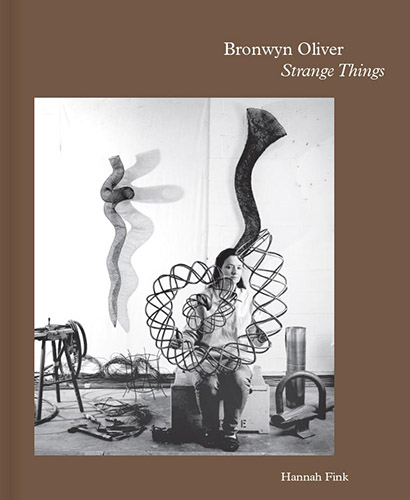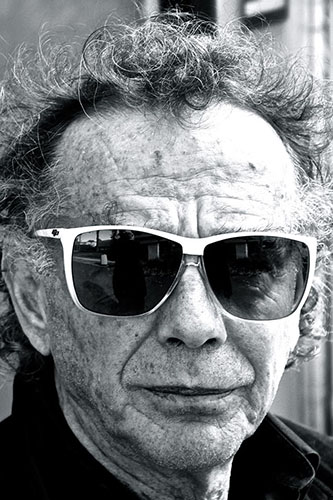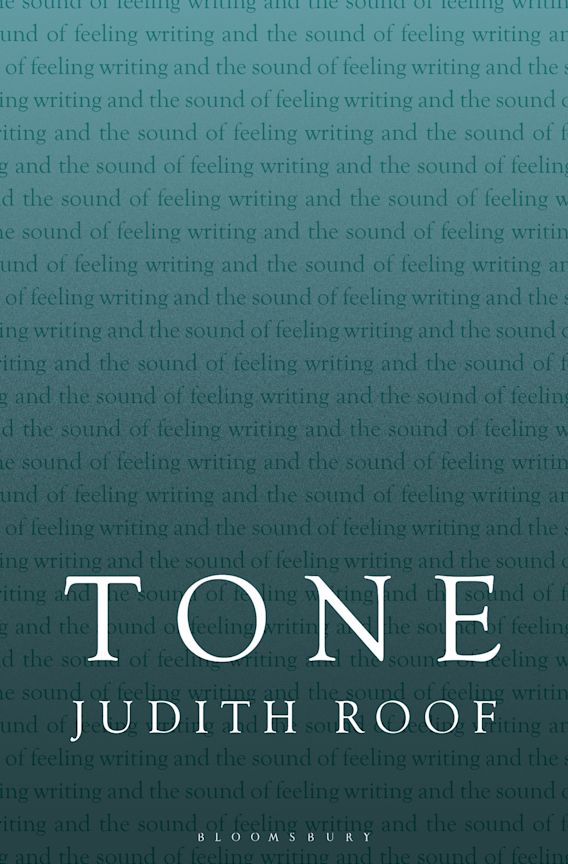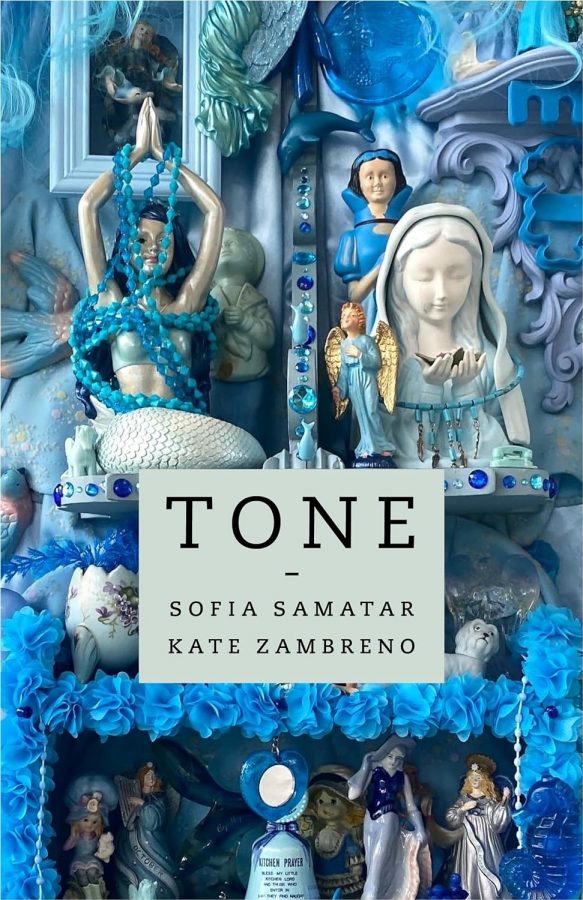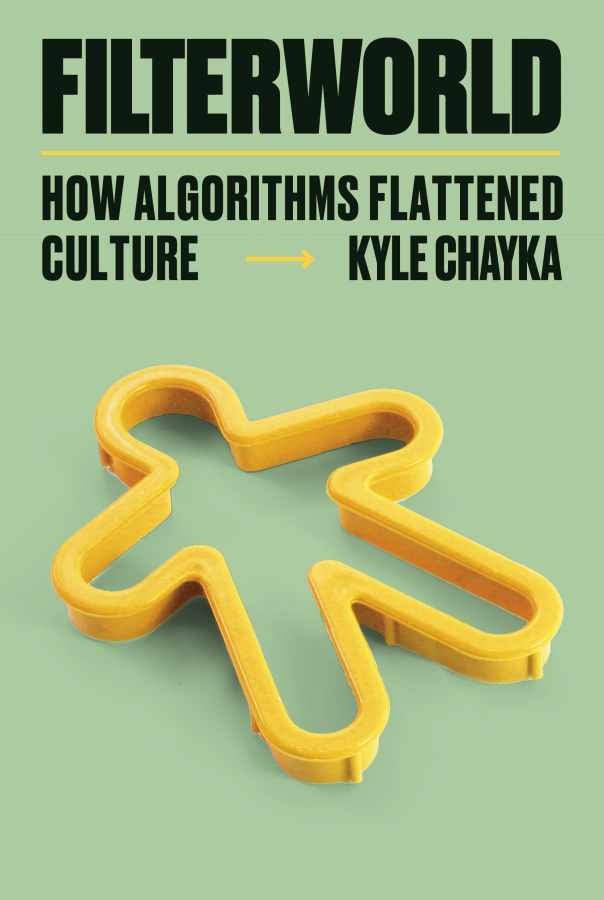I
About an hour into Blurred Lines: Inside the Art World (2017), Barry Avrich’s 90 minute documentary about the business of contemporary art, there’s a moment when you hear Marina Abramović say that the most important thing for an artist isn’t money or fame; it’s knowing ‘when to stop and how to die’. I paused the film. What did she mean? I had just read Strange Things, Hannah Fink’s exemplary account of the life and work of sculptor Bronwyn Oliver, and was mulling over the book’s complexities; Abramović’s remark seemed to be a clue leading to the heart of Oliver’s strangeness. When to stop and how to die, indeed. It’s a question we might ask of a civilisation, as much as of an artist; but artists (don’t they?) tend to bear the existential load of civilisation upon their shoulders; and entertain its complexities in their own hearts and minds.
Curiously, or perhaps not, Oliver and Abramović knew each other. They met in August 1981 at a bush retreat workshop, Beyond the Tick Gate, organised by Ian Howard (teenage Bronwyn’s art teacher in Inverell and subsequently head of the art school she attended in Sydney) at a farm cottage at Whiporie, between Grafton and Lismore in northern New South Wales. Eight students were invited to join Abramović and her partner Ulay on the week-long retreat, which included a two-day fast and a day of silence. ‘It was an intense and radical group of participants,’ Abramović recalled. ‘Their dedication to the workshop formed a very strong community.’ Though in fact, according to Fink, Bronwyn, then still using her birth name Gooda, along with some of the others, actually resisted the pull towards what she, Fink, calls ‘group think’.
Each of the participants was required to come up with a performance piece. On the last night of the retreat, Bronwyn presented Getting Through. She had herself sequestered inside a public phone box near the general store at Whiporie and, while the rest of the group stood around outside, made, using a single 20 cent piece, a series of phone calls, none of which was answered: until one of the company heard, distantly, through the cold and the dark of the night, the telephone ringing in the cottage down the road where they were all staying. He ran back to answer it, spoke briefly to Bronwyn, then returned and cut away the ropes imprisoning her in the phone box; and so let her go.
At this point, Gooda/Oliver was already making sculpture; but she was also doing other pieces of performance art. In White Pages she wrapped her body, including her arms and legs and head, in bandages, put on a waistcoat and a tie and, reading through a slit like a visor, recited names from the telephone directory as she travelled on the commuter ferry from Kirribilli across the harbour to Circular Quay. The work was documented on film, with audio that included the sound of paper tearing. This was in 1979, when the vogue for performance art was culminating in some extremely confronting acts of mutilation and self-mutilation. At one Sydney show, for example, an artist lay stripped to the waist, face down upon a table, and requested members of the assembled crowd to carve their initials into his back with a scalpel; most complied. Others fled.
Apropos this kind of event, Kim Machin, another of the participants in Beyond the Tick Fence, observed: ‘Performance had nothing to do with theatre. It was about truth to materials and actions.’ Even if the material was flesh and blood; and the action mutilation. Given the circumstances of Oliver’s death — self-inflicted, by hanging — the rope around the telephone box at Whiporia, and the act it encompassed, take on a peculiar resonance; as do the bandages in White Pages. But Oliver—it was her married name, assumed after she wed film-maker Leslie Oliver in 1980 — was also working with paper, cane, string, hair, wood, making the first of the enigmatic objects which would come to define her oeuvre. Many of these early constructions were crafted in London, at the Chelsea School of Art, where she had gone on a Travelling Art Scholarship, in 1982. Her habit of attaching one word titles to these works began at this time too: Unicorn, Polyp, Tentacle, Hermaphrodite.
In another intersection with a now famous artist, sculptor Anish Kapoor, the son of the Chief Hydrographer of India, was her flatmate for a time in South Kensington: he whose studio would later be granted exclusive rights to the artistic use of Vantablack, a pigment so dark it absorbs 99.9 per cent of radiation on the visible spectrum. More to the point, Kapoor in 2008 said:
It’s as if the collective will comes up with something that has resonance on an individual level and so becomes mythic. I can claim to take that as a model for a way of thinking. Art can do it, and I’m going to have a damn good go. I want to occupy the territory, but the territory is an idea and a way of thinking as much as a context that generates objects.
This is a view which might also be used to characterise the large works of public sculpture Oliver would make in the decades to come. They are as if generated out of her part in the evolving consciousness of the species.
After the London experience (there were to be other residencies, in France, twice, and in New Zealand; trips to China and Japan), she returned to Sydney and, in quick succession, found a job and a gallery. The job was three mornings a week teaching young boys art at Cranbrook Junior School in Bellevue Hill; she would go on doing this for nineteen years. The gallery was Roslyn Oxley9, which would show Oliver’s work for the rest of her life, and continues to represent her today. She formed a close relationship with Roslyn Oxley herself; they would talk daily on the telephone. Oxley said of her first meeting with Oliver: ‘A lot of artists are clever, they’re intelligent, they can draw, but they don’t have that thing you’re looking for in an artist. With Bronwyn I didn’t have to think about it. I was struck by her integrity.’
Her first show there was in 1986. Nothing sold but the notices were good. Elwyn Lynn wrote in The Australian:
Bronwyn Oliver’s marine shells of paper and fibreglass are about protective coverings from which the life they shielded has gone, but these carapaces retain the menace and predatory intent of their former inhabitants, delicate as their surfaces may be. As the medieval armourists knew, there is no armour against fate, but at least the armour can be beautiful.
Oliver would always feel the need to contradict those who saw natural forms as the basis of her sculpture; but concepts like armour, hollowness, carapace, menace and fate would continue to inform her work. So would the sense that her objects had some kind of life which has since departed; or that they have come and gone from another realm.
Anish Kapoor has denied any autobiographical intent to the things he makes. So, perhaps, would Oliver, if she had been asked, or answered, that particular question. She said she wanted her works to speak, not about themselves, but about a grand completeness of which they are a part. She wanted ‘to make objects that disappear even as they are perceived’. You might say that there is a dialogue in her work between the evanescent and the enduring. They are hollow, after all, most of them; and cast ghostly shadows. Or they are locked, bound, veiled, caskets that cannot be opened and will never disclose their contents. And yet it remains difficult to resist the temptation to read them autobiographically. Hannah Fink, too, had somehow to reconcile the work and the life: isn’t that what art biographies are supposed to do?
II
Simon During remarked recently upon the paucity of good literary biographies: ‘Is there a genre that promises so much and delivers so little? The gap between life and work can’t be overcome, not even when the work is mainly about the life.’ The same might be said of most biographies of artists, which usually come to grief in that gap—or widening gulf. But Hannah Fink has written a very good book indeed and it is worth examining how she has done it. The first point to make is that her text has been assembled from a large number of different sources and is, to a degree, the transcription of an oral history of Bronwyn Oliver’s life and times. Some of the material is archival, but the majority is not: the fruit of more than thirty interviews, conducted by the author, with those who knew Oliver best. These include both of her long term partners, Les Oliver and the wine writer Huon Hooke; her family and close friends; her dealers and teachers; colleagues like photographer Bill Henson; as well as people, such as Abramović, more distantly connected.
A collage of voices, then, you might say; one which has been put together with such skill it is virtually seamless. Fink had the advantage of a personal acquaintance with Oliver, whom she formally interviewed in 1999; and has written about her before. She also had access to her correspondence, journals and diaries, as well as to one other extensive interview (with Maggie Gilchrist, in 1987); and Oliver’s own artist’s statements made at various points in her career. Still, many biographies have foundered upon the rocks of too much, rather than too little, information; perhaps this one succeeds so well because of the peculiar dynamism of Oliver’s personality and the remarkably strong drive apparent in the way she made her work and in the manner in which she lived her life.
The two were not really distinct; which may be another reason why Fink’s assembly remains, to an almost hallucinatory degree, persuasive: as if the life were being narrated by the dead artist herself. And here a second point needs to be made. Fink has, it seems, a complete grasp of the oeuvre. She knows all the works, when and where and how they were made, the sequence in which they appeared, where they ended up and what they look like now. These works are superbly illustrated, mostly in black and white photographs, and comprehensively catalogued; they are also keyed to the text in a way that enlarges, without interrupting, the reading experience. There are very few works mentioned which cannot be found on the page, the opposite page or a few pages away. You read, and you look, in tandem; as it should be.
So here’s a third point: Bronwyn Oliver was a scrupulous, not to say obsessive, record-keeper. She documented everything she made and also kept meticulous accounts of expenditure upon materials, something not many artists do. We know quite a bit about Vincent van Gogh’s paints and canvasses, for example, but only because he was always writing to his brother asking for supplies; and inter alia, describing the uses he made of the materials Theo had already sent. Oliver’s record-keeping was of another order: almost like the entries some have imagined a recording angel making in God’s great register. She was already seeing her work in the light of eternity, perhaps; or, in a more mundane sense, in terms of posterity.
Fink is as scrupulous, in her way, as her subject was. By which I mean she is able, most of the time, to avoid comment. She doesn’t editorialise. The significance of events in Oliver’s life is allowed to emerge from contemporary testimony, perhaps, or from narrative juxtaposition, or simply because of the baleful grandeur of Oliver’s commitment to her work and the sometimes alarming consequences of her dedication. An example of this is her extraordinary decision to divorce, as she put it, her family: country folk from New England, who loved and admired the daughter who refused to see, or even communicate with them, for some years before her death in 2006. Fink describes this extreme decision without attempting to account for it. It is, like her subject, non-negotiable. A locked casket, perhaps.
She does, however, essay interpretations of the work; though not in any definitive sense. Her remarks are descriptive or intuitive; she suggests but does not insist upon meanings. This hesitancy in her readings preserves the strangeness of the works, their identity as things which seem to have appeared out of another dimension, or from another planet. Or, my own preference, as objects generated by the same forces that made life on earth, but constructed according to a slightly different set of variables: mutant DNA perhaps, or a subtle recursion of the mathematical series we call the Fibonacci numbers. A Mandelbrot set made with some aberrant equation at its base. What might this other equation be?
III
Oliver began working with metal in the mid to late 1980s and continued to do so until her death. Mostly, but not exclusively, copper; a material she loved. She might begin with a drawing; then construct a mould; around which threads of copper would be woven to make the object. The last stage of the process was the burning of the mould, which would of course leave traces upon the metal of the sculpture; which then began the long process of weathering through time. The technique of weaving copper wire was laborious, arduous and often painful: her hands were frequently cut or burned, there were always wounds upon her flesh. She would sit before a low bench, with pliers or cutters in one hand, a small oxy-acetylene torch in the other. She was in the habit of keeping the studio windows and doors shut as she worked—even when she burned the mould, and acrid, maybe poisonous, black smoke filled the air.
These objects seem to have been conceived in the mind before being born in the world. They are fiercely imagined then beautifully realised. She made several statements about their origin, most of which focus open the processes by which they were made. She liked to say that she was following the dictates of the material; or, alternatively, that the demands of a certain geometric figure, iterated and re-iterated, led inexorably to her finished structures. Nevertheless she was open to all kinds of influences, from utilitarian artefacts, like the couplings on the riggings of yachts, to ancient sculptures. She had a long-standing interest in the history of metal-working and studied objects and forms from prehistoric times. Most early metal-work is devoted to weaponry, domestic utensils or jewellery used for personal adornment. Swords and beakers, armour and the accoutrements of amour. These associations enter Oliver’s work as well.
A Frenchman she knew in Brest compared her to Vermeer’s lacemaker, bent forward intently over her work; however, she wasn’t weaving soft cotton threads or the transparent extrusions of silkworms; but harsh, wounding metal, fragments of which she sometimes left, like ranks of spikes, protruding along a spine-like ridge. Some of her sculptures are hairy with wire, resembling the extensions you see in electron microscope photographs of archaea. There is, in all of her later work, an implied contradiction between forms which seem pliable, generative, indeed organic; and material which is chthonic, mineral, ripped from the earth, made according to the regime of fire, manipulated with cutters and blades. And yet the forms, if alien, are also exquisite. Some have leaden eggs incubating within their tubular, calligraphic spirals.
The Greek concept, kairos, comes to mind: it means timing, the ability to choose the right, the critical, the opportune moment, and was associated with both archery and weaving. Oliver’s timing, as expressed in her sculptures, was impeccable. In one sense it is what she, and they, give to her audience. I mean a window into great time, the eternity against which all of life and death reposes. She was certainly aware of this quality: she several times said to her partner, Huon Hooke, that when she was working well, the world became complete, the universe in harmony with itself and she with it. Sports people call that being in the zone. Lamentably, however, none of us can ever remain there for any length of time. For artists, it is what makes living worthwhile; but how do you live while not making? When to stop and how to die?
Oliver was prolific, she was always working, usually, in the latter part of her career, on commissions, some of which became large and complex public sculptures. She formed an ongoing, warm and productive relationship with a foundry in Enfield who made, under her supervision, the large works for which she is best known. But as her practice increased in complexity, in volume and intensity, she seems to have become more and more obsessive. She initiated a punishing regime, which required waking early, at 5 am (it took three alarm clocks to rouse her), and going on a seven kilometre run before breakfast and the beginning of work. That working day might go through until 11 pm. This routine evolved alongside dietary compulsions which focussed upon grains and fruit and vegetables, and precluded the eating of meat.
Her uncompromising drive made her difficult to live with. She was very private and frequently unsociable—though remaining intimate with a small number of close and dedicated friends—and seems to have suffered from an impulse to isolate herself even from those with whom she was most closely connected. When, in London, her marriage to Les Oliver failed, she suffered a breakdown of some kind. The ‘divorce’ from her family has already been mentioned. At some point her relationship with Huon Hooke, until then sustaining, also failed. He left the house they shared in Haberfield in the winter of 2006. Bronwyn Oliver, though she must have understood the reasons why he had gone, did not long survive his leaving. She had bought, she told several people, a rope. The last entry on the spreadsheet where she recorded her purchases was for the fixture, to be attached to the wall of her studio, from which she hung herself.
Analysis of hair samples after her death showed a very high concentration of copper in her body: nine times the normal amount. Such concentrations are toxic and the toxicity may have contributed to her state of mind in the period leading up to her suicide. She had also dangerously low levels of zinc, a result of her restricted diet. The materials out of which she made her art, then, had become incorporated into her own body; and her disciplined approach to exercise and food, rather than guaranteeing her health, actually diminished her well-being. Once again, it is impossible not to think of the dialogue between the mineral and the organic, between flesh and metal, played out in her work. She was often photographed with her sculptures and, without exception, these images suggest a disturbing contrast between the fragility of the body and the durability of the work. It is not really surprising that, in the end, she made a willed passage from one into the other. As a consequence, and not in a trivial sense, she does seem to live on in her work.
IV
A central difficulty in biography, at least of the posthumous kind, is at the same time its sine qua non: death itself. We may live with the increasing consciousness of our coming end, but we don’t usually know when or how or under what circumstances it will actually occur. In this sense, even the gloomiest amongst us live open-ended lives: there isn’t really any other way to go. The arrow of time hastens forwards, in one direction only, yet the end is never known until it arrives—the origin of that piece of antique wisdom recently re-stated by Tom Waits: ‘Call no man happy till he dies.’ Conventional biography endeavours to reconstruct the arc the arrow of time has made through an individual life, but it does so with the end already known. Which cannot help but distort. Lives are given, retrospectively, a narrative shape they did not have while they were being lived.
Bronwyn Oliver’s life seems to contradict this tendency in an unsettling manner. It seems she had an intuitive grasp of the way to solve Abramović’s conundrum: when to stop and how to die. Though the circumstances of her death are harrowing, and though we may wish to believe that, had things turned out differently, she might have lived longer, in fact her decision was made with a steely resolve to carry through an act which might be characterised as an immaculate consummation. Her final show at Roslyn Oxley9, for instance, was completed down to the last detail and, after her death, hung exactly according to her wishes.
So the sculptures remain. With their delicacy and their power; their quasi-organic forms; their resemblances to spores and seeds, to viruses and bacterium, to heavenly bodies or ancient stone circles; the harshness of their materials; the evanescence of their presence; their emptiness; their shadows. It may be that Hannah Fink’s account of Bronwyn’s life is given uncanny impetus by the nature and circumstances of Oliver’s death; by the same token, the works as illustrated in this fine book seem preternaturally alive. They leap off the page into your consciousness and remain there, breeding ancestors as much they may seed descendents. Fink, with Piper Press, has made a magnificent memorial to the artist, and a consolatory, indeed ultimately joyful, repository for her work.
I’ll end at the beginning: by quoting the book’s epigraph. It is from Book XV of Ovid’s Metamorphoses:
Since I have embarked on the wide ocean, and given full sails to the wind, I say there is nothing in the whole universe that persists. Everything flows, and is formed as a fleeting image. Time itself, also, glides, in its continual motion, no differently than a river. For neither the river, nor the swift hour, can stop: but as wave impels wave, and as the prior wave is chased by the coming wave, and chases the one before, so time flees equally, and, equally, follows, and is always new. For what was before is left behind: and what was not comes to be: and each moment is renewed.
This seems exactly right. Bronwyn Oliver was one of those rare people able to translate that ineffable flow into things we can see and feel and touch. I find it impossible to mourn her; instead, as this fine book suggests, both she and her work should be celebrated.
Works cited
All quotes from Strange Things by Hannah Fink except:
Marina Abramović in Barry Avrich dir., Blurred Lines: Inside the Art World (2017).
Anish Kapoor, quoted in Victoria Rimmell, The Closure of Space in Roman Poetics: Empire’s Inward Turn (Cambridge University Press 2015).
Tom Waits: ‘Misery’s the River of the World’ on Blood Money (2002).
